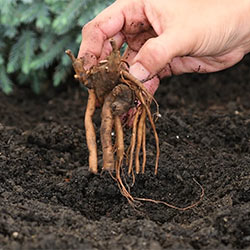They're also prized for their foliage that remains attractive throughout the growing season. These sun-loving perennials can be planted in mixed perennial beds, as a small hedge, or to line a walkway. You'll want to buy peony plants for their longevity; as they are some of the longest-lived perennials. Certain peonies can live for more than 100 years. The Itoh peony, a cross between a tree peony and bush peony, is growing in popularity because it delivers the best of both worlds. They have the sturdy stems of a tree peony and the large flowers of a bush peony. Peony bulbs can be planted in areas that receive full sun or partial shade. Be sure to check out our
care tips for peonies for more information. Explore our selection of gorgeous peony plants for sale and buy peony plants to bring new life to your garden today!
Do peonies need to be pruned?
Because peonies are tender perennials that grow back every year, they won't need to be pruned like roses or shrubs. Unlike some roses, peonies bloom only on new stems, so the old stems don't need to remain overwinter. In fact, peonies tend to die back naturally during the fall and winter. Allow your peony plants to wilt naturally, leaving the foliage out for as long as possible to allow the roots to gather energy from the leaves for the coming blooming season. In the fall, cut the stems down to the ground to clean up the garden and deter insects and pests from hanging around.
While you can cut your peony plants all the way back at the end of the season, during the growing season you'll want to keep an eye out for damaged or diseased foliage and branches. Using a clean pair of scissors or clippers, cut away the damaged pieces. Of course, you can harvest blooms from your peonies during the growing season, too!
Are peonies deer resistant?
Deer are known to dislike peonies due to their scent-most critters find the sweet, herbal fragrance of peonies a bit too heavy for snacking. However, a hungry deer or rabbit will graze on any plant, and peonies are tender enough to make a fine meal. Choose a location near your home or another active building to deter deer-security lights and human activity help to discourage them. If peonies in your neighborhood tend to be grazed, plant your peonies within a fenced area. Or, try a commercially-available animal repellent to keep deer out of your flower bed.
When should I plant peony bulbs?
Peonies should be planted while they are dormant, in fall or spring. In springtime, peonies should be planted just before the last frost date for your area, two to three weeks before the final thaw. In fall, aim for a planting date about six weeks before the final frost, to give your peonies time to become established before the harsh winter temperatures.
Peonies are quite hardy and easy to care for, but they don't like to be disturb once they're established. Make sure to choose a spot where you'll want peony flowers for a long time! If you do need to transplant your peonies, do so in the late fall during the dormant period.
How much water do peonies need?
How much you should water peonies depends upon the temperature and type of soil in which they live. New bare root and transplanted peonies need plenty of water during their first year as they become established in their new location.
Peonies are sturdy, but their roots don't grow deep-they grow near the surface, in clumps that can create new plants. As a result, their roots don't pull water from deep in the soil, so they can only reach the moisture in the first few inches of ground. That means watering regularly during dry spells is a must. Peonies are drought-tolerant for short periods, but do typically require an inch of water per week. In the spring and wet seasons, you won't need to water supplementally, but the regular use of a soaker hose during dry times is helpful.
As much as peonies appreciate regular watering, they don't care for compacted, boggy soil,and constant waterlogging can lead to root rot. Watering is a balance, so water deeply once per week.
What type of soil should peonies be planted in?
Peonies are adaptable to a variety of soil types, but they cannot deal with too much water constantly settled on their roots. Choose a location with well-draining soil, and aerate the soil well before planting. If you have heavy or clay soil, consider mixing in loam or mulch to keep the soil from settling in heavily around the roots.
Peonies don't require much in terms of feeding, but you can help their soil stay rich with an application of a balanced fertilizer at the beginning of the growing season, and again in mid-summer. A flower-friendly fertilizer will work well for this job.






















